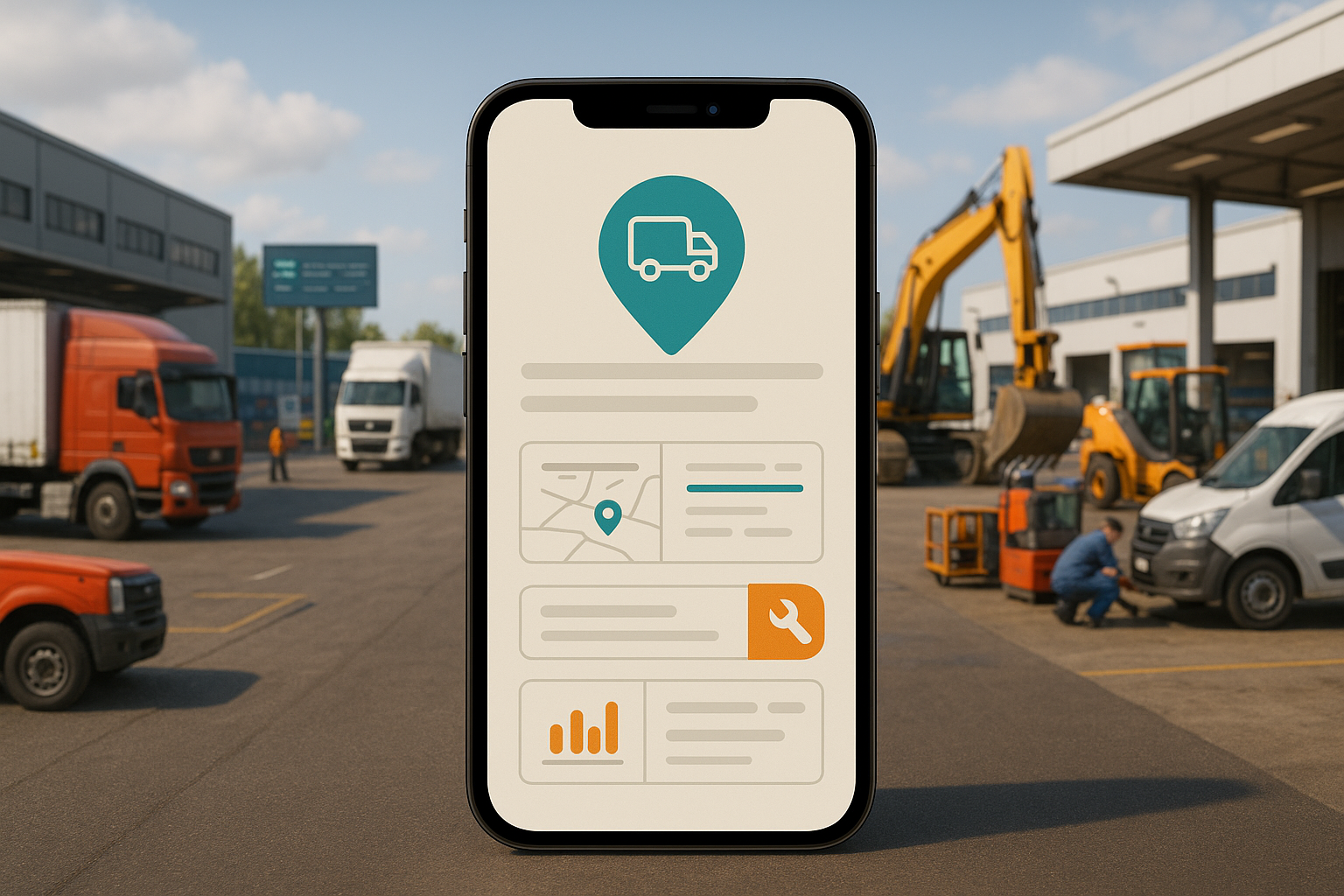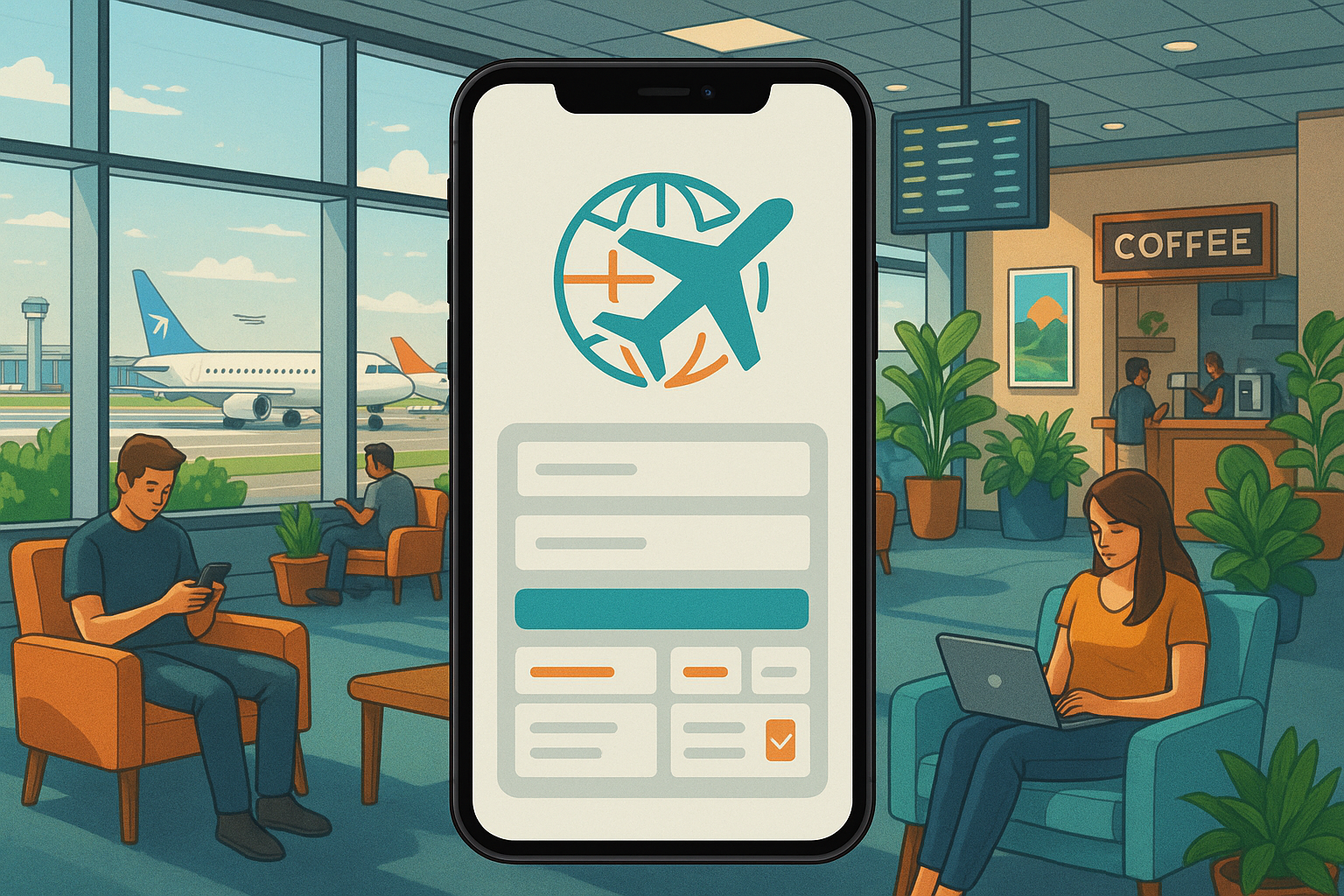Introduction
In today’s fast-paced, logistics-driven economy, the efficient management of a vehicle fleet is no longer a competitive advantage—it’s a necessity. From trucking and construction to healthcare and local delivery services, businesses rely on their vehicles, equipment, and drivers to deliver value. However, orchestrating this complex dance of assets, routes, fuel, and maintenance presents a formidable challenge. The solution lies in powerful, intuitive fleet management software, but developing such an application is a journey fraught with technical complexities.
Building a fleet management app requires more than just a map and some pins. It demands real-time data synchronization, sophisticated analytics, integration with vehicle hardware, and a seamless user experience for both managers in the office and drivers on the road. The sheer scope can be overwhelming for even seasoned in-house development teams.
This article serves as a comprehensive guide to fleet management app development. We will explore what defines a modern fleet management system, dissect the inherent difficulties of building one, categorize the different types of applications available, provide a realistic cost breakdown, and survey the top companies in the space. As a top US AI-powered app development firm, we at MetaCTO have extensive experience building complex, data-intensive mobile applications. We understand the challenges of integrating sophisticated systems like fleet management, and we are uniquely positioned to help you build a custom solution or integrate these powerful capabilities into your existing product.
What is a Fleet Management App?
A fleet management app is a centralized software platform designed to help organizations track, manage, and optimize their entire fleet of vehicles and assets. At its core, it leverages technology—primarily GPS, telematics, and data analytics—to provide a comprehensive, real-time view of fleet operations. This goes far beyond simple location tracking; a modern system is an all-encompassing command center for improving efficiency, ensuring safety, reducing costs, and maintaining compliance.
An effective fleet management application is built on a foundation of powerful, interconnected features that work in concert to provide actionable insights. These key features are the building blocks of a system that can transform a business’s logistical operations.
Key Features of Modern Fleet Management Software
Advanced GPS Tracking
This is the heart of any fleet management system, providing the foundational data for almost all other functions.
- Real-Time Location Tracking: Monitor the exact movements of your entire fleet as they happen. This immediate visibility allows for proactive decision-making rather than reactive problem-solving.
- Precision Location Map Charting: Visualize the precise location of every single asset on highly detailed maps. This granular view helps managers understand vehicle distribution, proximity to job sites, and current status at a glance.
- Route Optimization, Re-Routing, and Scheduling: Go beyond simple point-A-to-point-B navigation. These advanced algorithms consider variables like traffic patterns, weather conditions, and vehicle capacity to create the most efficient routes. The ability to adjust routes on the fly and optimize schedules is crucial for adapting to real-world conditions.
- Customer ETA Notifications: Enhance customer satisfaction by providing accurate, real-time estimated times of arrival (ETAs). This transparency builds trust and improves the end-user experience.
- Customizable Alerts: Tailor notifications to fit unique operational needs. Set up alerts for critical events such as a vehicle deviating from its planned route, unauthorized after-hours usage, or a driver entering or exiting a designated geofenced area.
Advanced Fuel Management
Fuel is one of the largest operational expenses for any fleet. Meticulous management is key to profitability and sustainability.
- Real-Time Monitoring: Track fuel levels and consumption patterns across the fleet in real time, eliminating guesswork and manual reporting.
- Fuel Analytics: Transform raw fuel data into actionable insights. Identify vehicles with poor fuel economy, analyze the impact of driver behavior on consumption, and find opportunities to reduce waste and support sustainability initiatives.
- Leak and Theft Detection: Quickly identify and address discrepancies in fuel levels. Instant alerts for sudden drops can signify a potential fuel leak or theft, preventing significant losses.
Driver Management and Safety
A fleet is only as effective as its drivers. These features help monitor performance, encourage safe behavior, and improve retention.
- Behavioral Analytics: Sophisticated algorithms analyze driving patterns to identify behaviors like harsh braking, rapid acceleration, and speeding. This data can be used for targeted coaching and training.
- Performance Metrics: Generate detailed reports on key performance indicators (KPIs) such as average speed, idling time, and adherence to planned routes. These metrics provide an objective basis for performance reviews.
- Retention Strategies: Use insights gleaned from performance data to recognize and reward top-performing drivers, implementing data-backed strategies to improve driver retention.
Fleet Maintenance
Proactive maintenance prevents costly breakdowns, extends vehicle lifespan, and ensures operational readiness.
- Preventive Maintenance Scheduling: Automate the scheduling of routine maintenance tasks based on predefined triggers like mileage, engine hours, or time intervals.
- Real-Time Malfunction Alerts: Receive instant notifications when a vehicle’s onboard diagnostics system detects a malfunction, allowing for immediate attention before the issue escalates.
- Maintenance History Tracking: Maintain a detailed, centralized digital record of all maintenance activities for every vehicle, providing a complete service history for compliance and resale value.
- Compliance with Regulations: Ensure adherence to safety regulations, such as those from the FMCSA, by generating accurate and timely Driver Vehicle Inspection Reports (DVIRs) digitally.
Comprehensive System Integration and Scalability
A fleet management app should not be an information silo. It must communicate with other business systems and grow with the company.
- System Integration: The software should harmoniously interact with other critical business platforms, including Customer Relationship Management (CRM) tools, Human Resources (HR) platforms, Transportation Management Systems (TMS), and supply chain management solutions.
- Data Synchronization: This integration facilitates the real-time exchange of data between systems, ensuring that all departments are working with the most current information.
- Scalable Architecture: The platform must be designed to grow with your business, seamlessly accommodating new vehicles, routes, and functionalities without a drop in performance or efficiency.
Reasons It Is Difficult to Develop a Fleet Management App In-House
While the benefits are clear, the path to developing a custom fleet management application is filled with significant technical and logistical hurdles. The sheer complexity of the required features, integrations, and infrastructure often exceeds the capacity of internal teams. This is why many businesses turn to specialized development partners.
The Challenge of Feature and Integration Complexity
The list of features detailed above illustrates the primary difficulty: breadth and depth of functionality. An in-house team would need expertise in a wide array of domains:
- Real-Time Systems: Building a system that can reliably process and display real-time GPS data from hundreds or thousands of vehicles requires a robust backend architecture and expertise in technologies like WebSockets and message queues.
- Hardware Integration: Connecting software to the physical world is notoriously difficult. Integrating with vehicle telematics devices and specialized hardware like fuel level sensors involves dealing with diverse protocols, data formats, and potential hardware failures. As cost analysis shows, even adding a fuel management sensor can significantly impact development complexity and cost.
- Third-Party APIs: A modern fleet app must integrate with numerous external services—mapping providers (like Google Maps or Mapbox), weather APIs, traffic data services, and internal business systems like a TMS or CRM. Managing and maintaining these third-party integrations is a continuous effort that adds to the development overhead.
- Data Analytics: Turning raw data into the “actionable insights” promised by these systems requires sophisticated data processing pipelines, algorithms for behavioral analysis, and the development of intuitive dashboards and reports.
The Demands of a Scalable and Secure Architecture
A fleet management app cannot be a simple web application. It must be built on a foundation that is both highly scalable and impeccably secure.
- Scalability: The system’s architecture must be designed from day one to grow with the business. An architecture that works for 10 vehicles will crumble under the load of 100 or 1,000. This requires careful planning of databases, server infrastructure, and load balancing—a core competency that may not be present in a typical business’s IT department.
- Security: The application will handle sensitive data, including vehicle locations, driver information, and customer details. Building a system with stringent security protocols to protect against data breaches is a non-negotiable requirement and a significant factor that increases development cost and complexity.
The Cross-Platform and UI/UX Conundrum
A fleet management solution serves at least two distinct user groups: fleet managers and drivers. Each has different needs and uses the app in a different context.
- Platform Diversity: Managers typically use a comprehensive web-based dashboard on a desktop computer. Drivers need a streamlined, easy-to-use mobile app on iOS or Android. Developing for a single platform is a major undertaking; building for web, iOS, and Android simultaneously, while ensuring data synchronization between them, multiplies the cost and effort.
- Custom UI/UX: Designing an interface that is powerful yet intuitive for a manager, and simple yet safe for a driver to use while on the go, is a major design challenge. Poor UI/UX can lead to user frustration, errors, and low adoption. Achieving a professional, custom UI/UX design is a significant cost driver in the development process.
Hiring a specialized custom mobile app development agency like MetaCTO mitigates these risks. We bring a team with diverse, pre-existing expertise in real-time systems, third-party API integration, scalable cloud architecture, and cross-platform mobile development. Instead of your business spending months or years trying to build this expertise internally, you can leverage our 20 years of experience to get a superior product to market faster.
Different Types of Fleet Management Apps
Fleet management is not a one-size-fits-all discipline. The right software solution depends heavily on how you access it, the industry you operate in, and the size of your fleet. Understanding these distinctions is crucial for selecting or building the right tool for your business.
By Access Method
- Web-Based GPS Fleet Management: This type of software is primarily accessed through a web browser on a computer. It’s the ideal choice for fleet managers, dispatchers, and analysts who spend most of their time in an office environment. These systems often feature comprehensive dashboards, detailed reporting tools, and customizable settings that allow users to prioritize the information most important to them. Software updates are typically managed by the provider, ensuring the user always has the latest version.
- Cloud-Based GPS Fleet Management: This is the mobile-friendly counterpart to web-based systems. Cloud-based software is designed for access from anywhere, at any time, using a mobile device like a smartphone or tablet. Providers usually offer dedicated mobile apps for both iOS and Android. This is the preferred solution for managers who are frequently on the go and need to track their fleet, communicate with drivers, and make decisions from outside the office.
By Industry
Different industries have unique logistical challenges, and specialized fleet management systems have evolved to meet them.
| Industry | Key Priorities & Features | Important Tools |
|---|---|---|
| Construction | Tracking vehicles, expensive equipment, and job site teams. Monitoring safety and unauthorized cell phone use. | Live Map, Asset & Machinery Tracking, Fuel & Mileage Reports, Safety Compliance Protocols, Vehicle Cameras, Driver Behavior Reports |
| Trucking & Car Companies | Managing vehicles that are on the road most of the time. Focus on routine maintenance, fuel efficiency, and driver communication. | Route Optimization & Tracking, Maintenance Notifications, Fuel & Mileage Reports, Driver Behavior Monitoring, Trip Inspections, Real-Time Wait Times |
| Healthcare | Different priorities focusing on patient care and security. Integration with mobile patient verification and paperwork. Tracking valuable mobile medical equipment. | Emergency Route Optimization, Mobile Check-in & Paperwork, Equipment & Asset Tracking, Enhanced Security Protocols, Mobile Time-Keeping, Quick Dispatch |
By Fleet Size
The scale of your operation dictates the level of complexity required from your fleet management software.
- Small Fleets (1-5 Vehicles): Businesses in this category, such as local HVAC, plumbing, or food delivery services, often need a simpler, more straightforward solution. The focus is typically on core functionalities like tracking vehicle locations around town, monitoring employee activity, and tracking assets.
- Mid-Size Fleets (5-20 Vehicles): As a fleet grows, so do its needs. These businesses often have vehicles traveling further distances and require more robust tools. Key features include mobile app tracking for on-the-go management, detailed fuel and mileage reports for cost control, and vehicle health reminders to manage a larger maintenance schedule.
- Large & Enterprise Fleets (20-50+ Vehicles): The demands of managing a large fleet are significant. These organizations need powerful tools that provide extensive oversight and management capabilities. Robust features become essential, including 360-degree location viewing of the entire fleet, advanced cost-saving analytics, sophisticated route optimization to manage complex logistics, and real-time ETA updates for numerous simultaneous jobs.
Cost Estimate for Developing a Fleet Management App
The cost of developing a custom fleet management application can vary widely based on its complexity, feature set, and the development team you choose. Understanding the primary cost drivers is essential for budgeting and planning your project.
General Cost Ranges
Based on industry data, development costs can be broken down into tiers:
- Basic Fleet Management Software: A solution with core features like basic GPS tracking and simple logging will typically cost between $8,000 and $15,000.
- Medium Complexity Software: Adding features like route optimization, driver behavior monitoring, and some third-party integrations will push the price into the $15,000 to $25,000 range.
- Full-Fledged, Complex Software: A comprehensive, enterprise-grade system with advanced analytics, hardware integrations (like fuel sensors), custom UI/UX, and cross-platform support can cost $25,000 to $40,000 and beyond, depending on the ultimate complexity.
Key Factors Influencing Cost
The final price tag is determined by a number of crucial factors:
- Number and Complexity of Features: This is the most significant cost driver. The more features you incorporate, the more development time is required. Advanced functionalities like real-time analytics, predictive maintenance, and fuel sensor integration will substantially increase the cost.
- UI/UX Design: A generic, template-based design is cheaper, but a custom, professionally designed user interface that is tailored to your brand and user needs will result in higher development costs due to the time and expertise required from UI/UX designers.
- Platform Choice: The platform(s) you build for heavily influences the price.
- A web-based application is generally less expensive to develop than a full-fledged native mobile app.
- Developing for a single mobile platform (e.g., Android only) will cost less than building for both iOS and Android (cross-platform development).
- Developer Location: Hourly development rates vary dramatically around the world. Development costs in North America and Western Europe are typically higher than in Asian or Eastern European countries.
- Ongoing Maintenance and Updates: The cost doesn’t end at launch. Budgeting for constant software updates, bug fixing, and the maintenance of third-party APIs and integrations is a crucial part of the total cost of ownership.
- Security and Testing: A simple application may require basic testing. However, a fleet management system handling sensitive data demands stringent testing protocols and robust security measures, which adds to the overall cost.
A Strategy for Reducing Costs: The MVP Approach
One of the most effective ways to manage costs and validate your idea is to begin by developing a Minimum Viable Product (MVP). An MVP includes only the core functionalities needed to solve a primary problem for your users. This allows you to launch faster, gather real-world feedback, and attract early adopters or investors before committing to a full-featured build. On average, an MVP development cost varies between $12,000 to $16,000.
At MetaCTO, our Rapid MVP Development service is designed to take your concept from idea to a market-ready app in 90 days, providing a cost-effective path to launching your fleet management solution.
Top Fleet Management App Development Companies and Solutions
When seeking a fleet management solution, you can choose between off-the-shelf software providers and a custom development partner. Here’s a look at the landscape, starting with the custom approach.
1. MetaCTO
As a premier US-based AI-powered mobile app development agency, we at MetaCTO specialize in building complex, scalable, and custom software solutions. Unlike off-the-shelf providers, we don’t offer a one-size-fits-all product. Instead, we partner with you to design and build a fleet management application tailored precisely to your unique operational needs, workflows, and business goals.
Why Choose a Custom Development Partner Like MetaCTO?
- Tailored Functionality: You are not limited by a predefined feature set. We build exactly what you need, from specialized integrations with your proprietary software to unique analytical dashboards that track your specific KPIs.
- Seamless Integration: With over 20 years of experience, we excel at the complex task of integrating software with third-party APIs, hardware telematics, and your existing business systems (CRM, TMS, HR), creating a truly unified operational hub.
- Scalable Architecture: We build applications on a flexible, scalable architecture designed to evolve with your business. You won’t outgrow your software.
- Expert Guidance: Building an app is a major undertaking. We provide deep technical partnership, acting as a Fractional CTO to help you build a technology roadmap that increases profit and valuation.
- AI-Powered Solutions: We can integrate cutting-edge AI technology to provide predictive analytics for maintenance, advanced driver coaching, and intelligent route optimization that goes beyond the capabilities of standard systems.
2. Geotab
Geotab is a global leader offering telematics technology. Their platform provides real-time GPS tracking, driver behavior monitoring, and fuel usage analytics. Geotab helps organizations enhance safety and cut down on operational costs.
3. Samsara
Samsara is a fast-growing company known for its comprehensive Internet of Things (IoT) solutions. Their user-friendly, cloud-based platform includes telematics, safety compliance features, and real-time vehicle tracking. Samsara’s rich analytics help businesses improve driver safety, reduce fuel costs, and stay compliant with regulations.
4. Fleet Complete
Fleet Complete caters to a wide range of clients, from small businesses to multinational corporations, with one of the most extensive ranges of fleet management services. Their solutions include asset tracking, vehicle diagnostics, driver safety monitoring, and maintenance scheduling, all accessible through an easy-to-use platform that gives managers real-time insights.
5. Teletrac Navman
A leader in innovative fleet management, Teletrac Navman delivers solutions tailored to various industries. Their telematics systems provide advanced fleet tracking, driver behavior analysis, and compliance reporting. The customizable platform can be fine-tuned to meet the specific needs of diverse fleets, from small businesses to large enterprises, enabling high levels of operational efficiency.
6. Omnitracs
Omnitracs is an industry leader known for innovative software focused on efficiency, compliance, and safety. A key feature is their predictive analytics tools, which help businesses anticipate maintenance needs to avoid costly breakdowns. The platform also includes solutions for route optimization, fuel management, and automated driver workflows, making it a great fit for large fleets with complex logistical needs.
7. Verizon Connect
Verizon Connect provides powerful and scalable fleet management solutions suitable for businesses of all sizes. The comprehensive platform offers GPS tracking, route optimization, fuel monitoring, and maintenance alerts. Verizon Connect’s ability to scale from small businesses to enterprise-level fleets gives it an edge in flexibility.
8. Donlen
With over 50 years of experience, Donlen is a veteran in the space. They offer comprehensive services focused on reducing costs and improving fleet efficiency. Their platform specializes in vehicle lifecycle management, helping businesses track assets from acquisition to disposal. Their in-depth analytics enable companies to manage fuel consumption, improve safety, and optimize maintenance schedules.
9. Trimble Transportation
Trimble Transportation stands out by integrating fleet management with broader supply chain solutions. Ideal for companies needing comprehensive logistics optimization, their platform offers fleet visibility, route planning, driver safety monitoring, and compliance tools. They also offer mobile solutions that allow for real-time decision-making to improve overall efficiency.
10. Masternaut
Part of the Michelin Group, Masternaut specializes in telematics and fleet management solutions focused on reducing fuel consumption and CO2 emissions. Their platform provides real-time tracking, driver behavior monitoring, and detailed analytics to improve both efficiency and sustainability, making it an attractive option for environmentally conscious companies.
11. Azuga
Azuga is a top choice for small and medium-sized fleets, offering a simple yet powerful platform. Their solutions are designed to improve operational efficiency and ensure compliance. The platform provides fleet tracking, driver safety monitoring, and maintenance scheduling, and features safety scorecards for drivers, real-time diagnostics, and alerts to help businesses reduce costs and improve productivity.
Conclusion
The journey into fleet management app development is a significant undertaking, but one that promises transformative returns in operational efficiency, cost savings, and safety. We’ve explored the rich tapestry of features that define a modern system—from advanced GPS tracking and fuel analytics to preventative maintenance and driver management. We’ve also navigated the considerable challenges of in-house development, highlighting the complexities of feature integration, scalability, and cross-platform design that make partnering with an expert firm a strategic imperative.
Understanding the different types of applications—categorized by access method, industry, and fleet size—is the first step toward identifying the right solution for your unique context. Coupled with a clear view of the development costs and the key factors that influence them, you are now equipped to make an informed decision. Whether you opt for an established off-the-shelf solution or pursue a fully custom build, the goal remains the same: to gain control over your fleet and turn it into a streamlined, data-driven asset.
Building or integrating a powerful fleet management solution requires deep technical expertise. If you’re ready to create a system that is perfectly aligned with your business needs, we are here to help. Talk with an expert at MetaCTO to discuss how we can integrate world-class fleet management capabilities into your product and drive your business forward.






